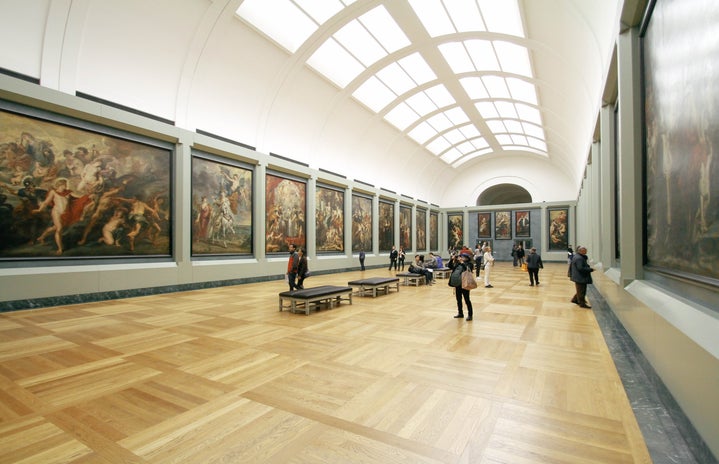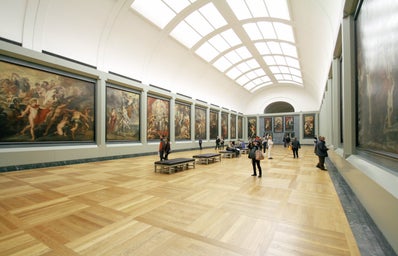As someone who has lived in Richmond for several years now, I’ve been to the Virginia Museum of Fine Arts several times. More commonly known as the VMFA, this giant building holds some of the most widely varied and interesting works of art present within the city of Richmond. Even though I’ve been more than once, I still haven’t managed to make my way through all of the exhibits. I feel that no matter how many times I do end up going, there will always be an extra little room or side hallway that I would have missed the time prior. The art styles present at this museum range from ceramics to painting to pieces valued largely for their historical significance.
Just like the exhibits themselves, the artists also range in both culture, presentation and preference for artistic medium. Although I’ve always just enjoyed wandering through the halls of the VMFA without much direction beyond that of what glitters enough to catch my eye, I have occasionally wondered what it would be like to move through the space as someone who both knows and understands the artists behind the artwork.
In light of it being Black History month, I feel that becoming more aware of some of the lovely and talented Black artists who have their work displayed would be a good way to start this new awareness. Here is a list of several Black artists and their motivations behind the creations available for viewing at the VMFA. Of course, this list doesn’t include all Black artists with work present in the VMFA. However, they all had specific pieces that caught and held my attention. These artists are not ranked on skill level or personal preference, but rather as possible artists you may find worth checking out.
- Kehinde Wiley
-
If you’ve ever been to the VMFA, you will probably recognize this piece. I remember the proud figure and vibrant colors being one of the first things I noticed when entering the museum for the first time my freshman year. What I didn’t know was anything about the artist and his motivations behind the work. Yes, this man’s attitude, sword and all-white outfit made him cooler than I will ever be, but who was responsible for making him this way?
Kehinde Wiley is an American painter and created this work in 2006. I thoroughly enjoyed reading about his reasoning behind what he chooses to create. He describes it as simply wanting to make things that people see, recognize and can relate to/appreciate. He says that one of the main joys of becoming a fairly successful artist is the number of African-American kids that will approach him after viewing his work and saying they’re grateful to finally see something they recognize in art.
Being able to create and display a painting that is just as familiar to these children as it could be to a seasoned art historian is something that he has become very proud of, and rightly so, in my opinion. As stated on the VMFA website, he claims it to be a rarity to see people who “look like me” and that being able to present work that shows off and empowers the viewers (like young African Americans at a location as well known and renowned as the VMFA, is a dream come true.)
- Charles White
-
Strangely enough, when asked about how and why he became an artist, Charles White’s answer actually involved mostly music rather than the medium to which he became known. He grew up learning the violin, becoming a fairly accomplished child musician after nine years of practice before moving on to incorporating modern dance into his ever-growing list of skills. Even though the beginning years of his life seemed very focused on that of music, he eventually turned to illustration as his true passion. His works largely consist of charcoal sketches and scenes. Unsurprisingly, however, his love of music shone through, even in this new medium.
Perhaps his most famous piece and the one displayed at the VMFA depicts a young black man playing the guitar. It is entitled “Guitarist” (clever, I know) and managed to capture his myriad of interests on a singular piece of canvas. As an artist, Charles White has mentioned that although he takes great pride in being black, his works aren’t hugely motivated by anything relating to race. Rather, he focuses primarily on creating things he finds familiar or similar to himself and his cultures in order to express his honest feelings on universal truth and beauty.
- Beauford Delaney
-
Perhaps the most widely known artist on this list—I had definitely heard the name Beauford Delaney before. According to the VMFA website, one of the main motivators behind his work was the soul and spirit of New York. Delaney moved to NY during the beginnings of the Great Depression, and it exposed him to a people and parts of the world he had never seen before. He described the initial move as terrifying, with the city being so immense and new. What I found truly interesting was the man’s claim that he has “never drawn a decent thing until he felt the rhythm of New York.”
The fact that someone can find such inspiration in a place that they go from “barely decent” to something he and other people take great pride in is amazing. Although his artwork clearly reflects the physical aspects of New York (such as fire escapes, street corners and jazz clubs), Delaney spent more time focusing on communicating the feeling and energy that living among all these thrilling activities could bring. Perhaps this is why the majority of his works seem more abstract in nature, as the colors and textures blend together in a whirlwind of feeling rather than any attempt at a picture-perfect copy.
- Leslie Bolling
-
Leslie Bolling is also unique in that he was more based in 3D work than many others. From the very beginning, he claimed to have enjoyed working with his hands. He said this kind of art made him feel grounded and solid. He began with layering paper and cardboard in order to create depth, and then into slightly more advanced woodwork and blacksmithing. He actually ended up moving to and attending Virginia Union University in Richmond to receive more formal training on these two subjects.
His work started to become widely known after the writer Carl Van Vechten brought attention to it from the Harmon New York foundation. This resulted in Bolling’s sculptures being shown off at several exhibitions across the country and he became the first black artist to have a solo exhibit in Virginia. Due to this combination of success and talent, his work is currently being proudly displayed at the VMFA.
- Robert S. Duncanson
-
The earliest artist on this list, Robert Duncanson, was born in 1821 and lived until 1872. He was the grandson of a free Virginian slave and was largely self-taught when it came to his beginnings in art. As a young man, he formally worked on the interior of houses but was also busy advertising himself as a painter and artist in the local paper. When he moved to Cincinnati years later, he had already started painting landscapes and portraits. A local businessman helped him continue publicizing his works, and his talents were soon noticed by some nearby wealthy families. Business was good, and by 1853 he had saved up enough money to travel to Europe, where he spent time studying sculpture and landscapes in Florence and London.
During this time period, Duncanson ended up selling a sketch of the Scottish Highlands known as “The Land of the Lotus Eaters” to the king of Sweden (as one does). As if this weren’t wild enough, he continued to travel even after returning to the states. He went from state to state, studying and painting landscapes, perhaps in preparation for happening upon another king of sorts.
According to the VMFA website, as a black man, Duncanson was often questioned as to why he didn’t make more of a point of race within his works of art. Although I would have assumed it was because landscapes are generally more focused on trees and pretty lighting than race, Duncanson claimed that he had “no color on the brain, all I have on the brain is paint.” He tried to highlight his surroundings and bring love and beauty into them, and looking through his wonderfully painting forests and street corners; I would say he succeeded.
As someone who has always enjoyed going into museums, I’m sometimes surprised by how little I usually know about the artists. This always seems vaguely disrespectful, but it isn’t meant to be. As the majority of this art is visual, I tend to stop and pay attention to what sticks out, and some work (including those mentioned on this list) is either too subtle or too tucked away in a corner for me to truly appreciate it.
Regardless, that managed to make this brief bit of research very informative and interesting. I like to think that if I go back to the VMFA in the near future, I’ll be able to flex a certain number of random artist facts to whomever I am with at the time. And even if that isn’t the main motivator for you, I do recommend either checking out these artists at the VMFA or doing a bit of personal research online.



